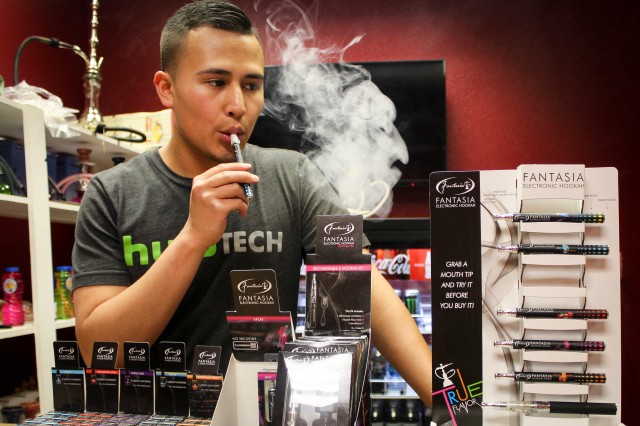Teen E-Cigarette Use Raises Red Flags for Health Authorities

Albert Toca, owner of Ontario Hookah Lounge on East Riverside Drive, demonstrates how to smoke an e-cigarette. Photo by Jhannet Sanchez.
By Jhannet Sanchez
For Reporting Texas
A growing percentage of U.S. teenagers is trying electronic cigarettes, and that has health authorities worried, even as some retailers salivate over a new market.
The federal Centers for Disease Control and Prevention reported in late 2013 that more than 1.7 million, or 2.8 percent, of middle school and high school students had smoked e-cigarettes in the previous year. That represents an increase from 1.5 percent in 2011.
While teen e-cigarette usage is low compared to the 23.3 percent who use tobacco, the trend is troubling on several levels. There is no government regulation of what electronic cigarettes contain or how they are marketed. Although they contain nicotine, in most areas, the minimum age at which teens can buy the electronic smokes is 16 – two years under the legal age for buying tobacco.
There is no data on the long-term health effects of e-cigarettes, and too little information about the chemicals they contain, said Dr. Michael Huang, medical director of the Austin-Travis County Health and Human Services Department.
“E-cigarettes are the sort of situation that should be guilty until proven innocent,” he said.
The slender, battery-powered devices, some of which look like cigarettes, heat a liquid so that users can inhale the vapor.
E-cigarette sales skyrocketed from $195 million in 2011 to $500 million in 2012 and more than $1 billion in 2013, according to industry reports.
Teens are coming together at so-called vaping lounges where they can socialize, hang out and relax while puffing on e-cigarettes.
One of the new e-cigarette smokers in Austin is 18-year-old Nathan Karethi, a McCallum High School senior. Like many e-cigarette smokers, he likes being able to choose from flavors that include various fruits, chocolate and mint. There’s even one based on horchata, a beverage popular with many Latinos.
“I usually get sweet or bubble gum flavor,” Karethi said.
The flavors raise a red flag for Huang and other health experts.
“There are no regulations regarding what additive chemicals are added to e-cigarettes,” Huang said. “So there are all these different flavors and we don’t know what’s in every different flavor. What chemicals they are adding to these things?”
E-cigarettes contain nicotine and diethylene glycol, an ingredient used in antifreeze, according to the Food and Drug Administration.
E-cigarettes allow users to control how much nicotine they inhale, a potential danger. The nicotine density is listed as the number of milligrams per milliliter in the e-liquid solution. So smokers may put three drops of e-liquid into the cartridge to use a total of 3.6 milligrams of nicotine. Traditional cigarettes vary from 0.7 to 1.7 milligrams each, depending on the brand.
Some e-cigarettes use cartridges that provide 200 to 400 puffs, equal to two to three packs of cigarettes. Other e-cigarettes use refillable tank systems that can last from a few days to a month, depending on their size.
Karethi said he usually uses e-cigarettes when he’s socializing.
“Some teens do it for the buzz or just to look cool,” Karethi said.
The e-cigarette market has been growing steadily since the new smokes were introduced in 2007. The Tobacco Vapor Electronic Cigarette Association, founded in 2008, is expecting sales to surpass those of traditional cigarettes in just 10 years.
E-cigarettes have attracted the interest of retailers such as Albert Toca, who sells them at the Ontario Hookah Lounge in East Austin, which he opened in February.
“I was hearing testimonies from people who smoke and from smoke shop owners around the city. It’s exciting to be part of an entirely new market,” Toca said. However, he added a caution: “Not enough research has been done on whether there are negative effects from second-hand smoke of e-cigs,” referring to the vapor the devices emit.
Toca said his customers have told him e-cigarettes have helped their social lives.
“Customers are beaming when they talk about their friends and families who are no longer offended by the smell cigarettes leave behind,” Toca said.
It took decades before the federal government regulated cigarettes, after a 1974 Surgeon General’s report outlined the health dangers. Federal regulations have not caught up with e-cigarettes, said Huang.
He is concerned about marketing terms, such as saying that users are “vaporizing” instead of smoking, and assertions that e-cigarettes are tobacco-free, even though they contain nicotine.
Texas does not prohibit stores from selling e-cigarettes to minors. A few cities in Texas do, including Murphy, a Dallas suburb, and the Fort Worth city council is considering it. Richardson requires a special permit to open an e-cigarette venture. Both Travis and Williamson counties ban their use by anyone on county property.